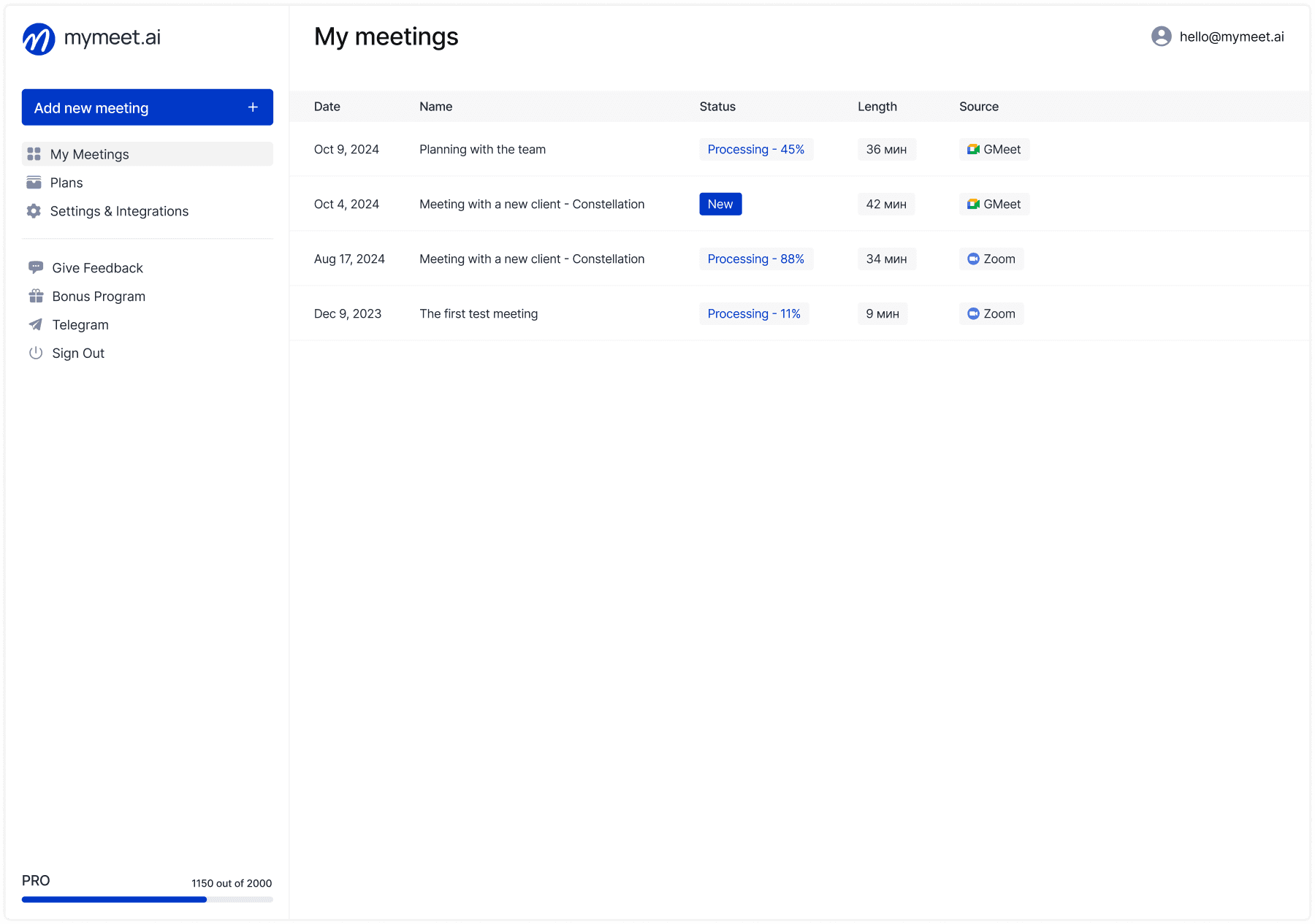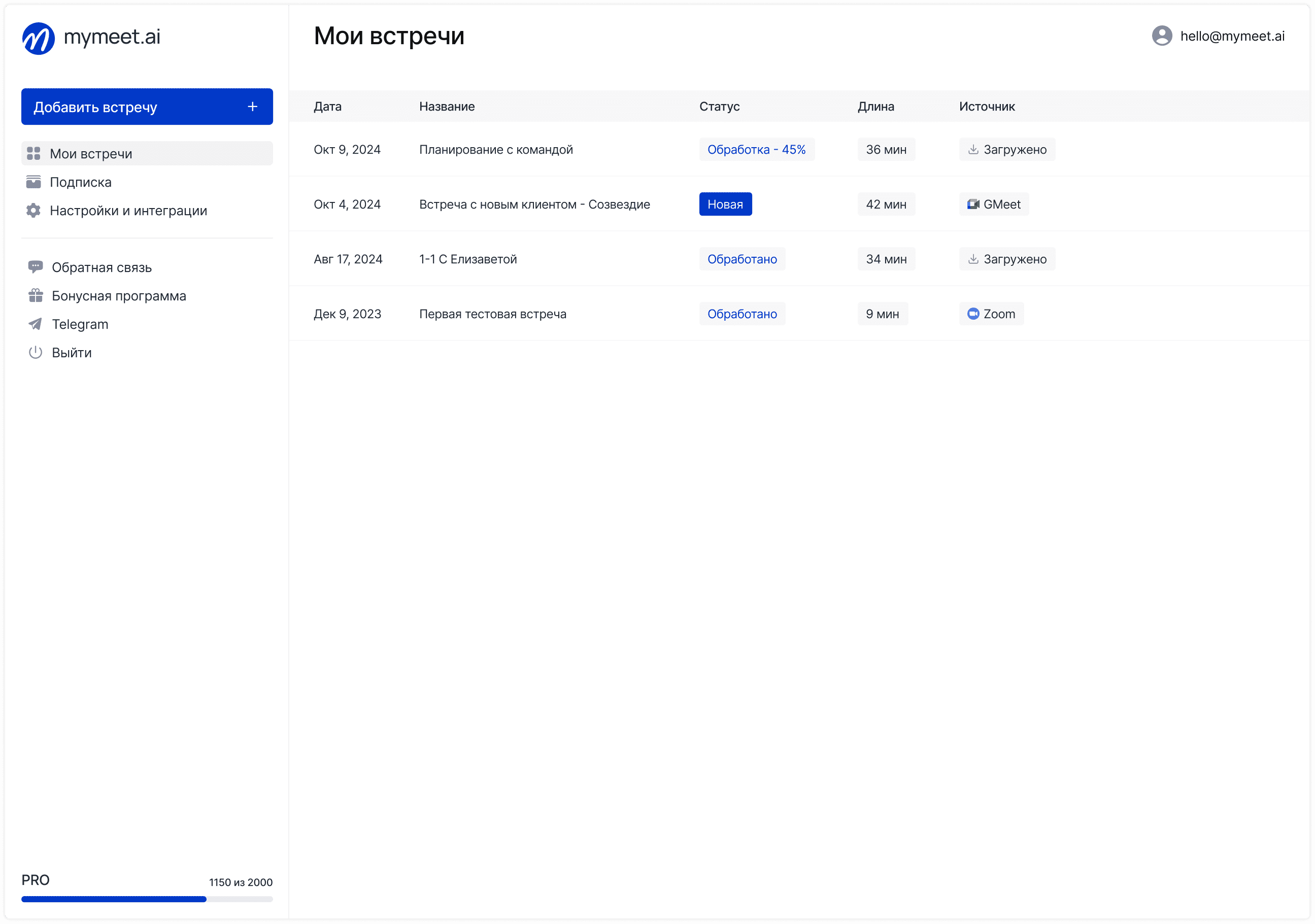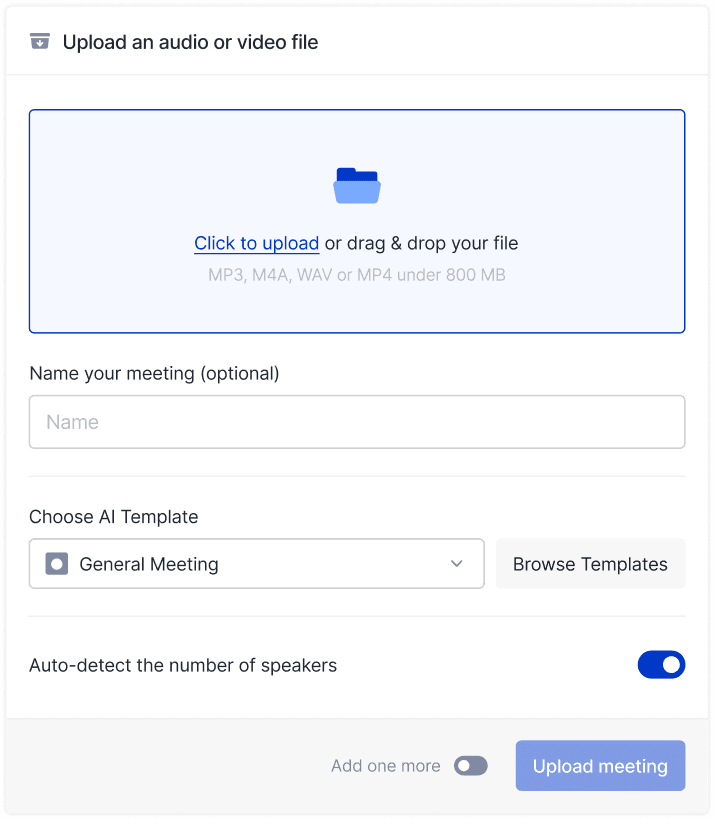Sales Mastery

Andrey Shcherbina
Jul 22, 2025
The manager of a retail chain ran the family business the old-fashioned way: product tracking in notebooks, phone orders, intuition-based planning. Competitors with online stores and mobile apps were rapidly stealing customers. Over 18 months, he radically changed the approach: implemented omnichannel sales, set up predictive analytics for purchases, and automated logistics. Results exceeded expectations: 40% sales growth, 25% cost reduction, and restored competitive position.
The mymeet.ai team helps global companies navigate digital transformation, starting with business communication automation. Understanding transformation stages and principles is critically important for modern business survival and development.
What is Business Digital Transformation

Digital transformation is a comprehensive restructuring of business models, processes, and corporate culture using digital technologies to create new customer value and increase competitiveness.
Transformation affects all aspects of organizational activity: from operational processes to strategic planning. The goal is not simply implementing technologies, but fundamentally rethinking ways to create and deliver customer value.
Digital transformation differs from automation in depth of changes. Automation accelerates existing processes, while transformation creates fundamentally new ways of conducting business. Companies transition from linear value creation chains to ecosystem interaction models.
Differences from Related Concepts
Digitization translates analog processes to digital format without changing operation essence. Digital transformation uses digital technology capabilities to create new business models and customer interaction methods.
Automation replaces manual operations with automatic systems to increase efficiency. Transformation rethinks the entire business approach considering digital capabilities.
Example of differences: bank digitization — converting document flow to electronic form. Automation — implementing an automatic loan approval system. Digital transformation — creating a financial services ecosystem with personalized offers based on big data analysis.
Why Digital Transformation is Needed
Modern business faces fundamental changes in customer behavior, competitive environment, and technological capabilities, making digital transformation a survival issue.
Key Digital Transformation Drivers:
Consumer behavior change — customers expect digital interaction experience
Competitive pressure — companies with digital advantages displace traditional players
Operational efficiency — technologies dramatically reduce costs and accelerate processes
New business models — digital platforms create additional revenue sources
Regulatory requirements — governments stimulate economic digitization through legislation
Customers are no longer willing to tolerate slow service, lack of online channels, and personalization. Companies that don't adapt to new expectations lose loyalty and market position.
Digital startups appear in all industries and often surpass traditional players in speed, convenience, and innovation. Established companies are forced to transform or risk being displaced from the market.
Risks of Transformation Lag
Companies ignoring digital transformation necessity face progressive deterioration of competitive positions. Customers switch to more technological competitors offering better user experience.
Operational costs grow due to outdated process inefficiency, while digital competitors reduce expenses through automation and optimization. The efficiency gap constantly increases.
Talented employees prefer working in technological companies with modern tools. Companies without digital transformation experience difficulties attracting and retaining best specialists.
Key Digital Transformation Directions
Successful transformation covers several interconnected directions, each contributing to overall change results.
Direction | Key Technologies | Expected Results | Application Examples |
Customer Experience | CRM, personalization, omnichannel | Loyalty growth, conversion increase | Mobile apps, chatbots |
Operational Processes | RPA, AI, IoT | Cost reduction, process acceleration | Document flow automation |
Business Model | Platforms, APIs, data | New revenue sources | Digital ecosystems |
Workplace | Cloud services, collaboration | Productivity growth, flexibility | Remote work, digital tools |
Analytics and Data | Big Data, machine learning | Decision improvement, forecasting | Predictive analytics |
Technological Transformation Foundations
Cloud computing provides IT infrastructure flexibility and scalability, allowing companies to quickly adapt to changing needs without significant capital investments.
Artificial intelligence and machine learning automate decision-making, personalize customer interactions, and identify hidden patterns in data for business process improvement.
Big data and analytics turn accumulated information into practical insights for strategic planning, operation optimization, and customer need understanding.
The Internet of Things connects physical objects to digital systems, creating new opportunities for real-time monitoring, management, and process optimization.
Digital Transformation Stages
Successful transformation requires a systematic approach with clear stage planning and coordination of all participant efforts.
Step-by-Step Digital Transformation Plan:
Current state audit — assessing organizational digital maturity and identifying opportunities
Strategy development — defining vision, goals, and transformation priorities
Roadmap creation — detailed planning of stages, resources, and timeframes
Pilot projects — testing solutions on limited scale to verify concepts
Scaling — spreading successful initiatives throughout organization
Process optimization — continuous improvement and adaptation to changing conditions
Current state audit includes IT infrastructure assessment, business processes, staff digital competencies, and organizational readiness for changes. Audit results determine transformation starting point.
Transformation strategy should be closely linked to the company's overall business strategy. It's important to define specific goals, success metrics, and expected results from digital solution implementation.
Detailed Stage Breakdown
Each transformation stage has specific tasks, tools, and success criteria that must be clearly defined for effective process management.
Pilot projects allow testing approaches and technologies on a limited area, minimizing risks and gaining practical experience. Successful pilots become the foundation for scaling solutions.
The scaling stage requires careful resource planning, staff training, and change management. It's important to maintain balance between implementation speed and realization quality.
Continuous optimization ensures adaptation to changing market conditions, new technologies, and evolving customer needs. Transformation is an ongoing process, not a one-time project.
Transformation Obstacles and Challenges
The digital transformation path involves multiple barriers, understanding and overcoming which determines entire process success.
Main Transformation Barriers:
Staff resistance to changes — fear of job loss and familiar process changes
Competency shortage — lack of specialists with digital skills in team
Limited budget — high initial investments in technology and training
Legacy systems — complexity of integrating new solutions with old IT infrastructure
Cultural barriers — corporate culture conservatism and innovation resistance
Staff resistance often becomes the main transformation obstacle. Employees fear new technologies will make their work unnecessary or dramatically complicate familiar processes.
Digital competency shortage limits an organization's ability to effectively use new technologies. Training and staff development become critically important investments.
Legacy IT systems create technical limitations for modern solution integration. Infrastructure modernization often requires significant investments and time.
Barrier Overcoming Strategies
Effective change management begins with clear communication of transformation goals and benefits. Employees must understand how changes affect their work and what new opportunities open up.
Training and requalification programs help staff adapt to new technologies and processes. Investments in people development often prove critically important for transformation success.
Phased financing with ROI demonstration at each stage helps justify further investments and maintain project management support.
mymeet.ai as Digital Transformation Tool

The mymeet.ai platform represents practical examples of how modern AI technologies can become catalysts for business communication digital transformation.

Key mymeet.ai capabilities for digital transformation:
✅ Business communication digitization using advanced AI technologies

✅ Document management automation and structured meeting protocol creation
✅ Corporate communication efficiency analytics implementation
✅ Integration with existing corporate systems through APIs
✅ Team digital maturity improvement through modern tools

✅ Enterprise-grade information security compliance
✅ Scalable solution for companies of any size and industry
✅ Advanced development with understanding of global business specifics
The platform demonstrates how AI can transform routine processes into valuable business insights sources. Automatic meeting analysis reveals successful negotiation patterns and helps teams improve communication efficiency.
TechFlow Solutions Case: Sales Process Transformation
TechFlow Solutions used mymeet.ai for digital transformation of client interaction process. Before implementation, the sales department spent 15 hours weekly creating client meeting reports and coordinating tasks between managers.
Mymeet.ai implementation automated client meeting analysis, key requirement extraction, and structured report creation. The AI system identifies client needs, tracks deal stages, and automatically updates the CRM system.
Transformation result: 15 hours weekly savings, customer service quality improvement, and sales conversion growth. The team gained the ability to focus on building client relationships instead of administrative tasks.
Train employees to work with the AI assistant. Submit an application via the form for a corporate webinar.

Digital Transformation Best Practices
Analysis of successful transformation projects reveals common principles adaptable for various industries and company sizes.
Proven Successful Transformation Principles:
Top leadership — active support and personal participation of senior management
Customer-centricity — focus on customer experience improvement as main priority
Iterative approach — gradual changes with quick feedback and adjustments
People investment — digital competency development as transformation foundation
Expert partnership — engaging external specialists and technology partners
Result measurement — clear success metrics and regular progress monitoring
Management leadership is critically important for creating change culture and ensuring necessary resources. Without top management support, transformation rarely achieves ambitious goals.
Customer-centric approach helps prioritize and focus efforts on initiatives creating greatest value for customers and consequently for business.
Maturity Level | Characteristics | Typical Companies | Next Steps |
Initial | Minimal digitization, manual processes | Traditional small enterprises | Basic automation |
Developing | Separate digital solutions | Medium business with CRM/ERP | System integration |
Defined | Coordinated digitization | Advanced companies | Data analytics |
Managed | Digital processes in all areas | Technological organizations | AI and automation |
Optimizing | Continuous improvement | Digital leaders | Innovation and ecosystems |
Measuring Digital Transformation Success
Effective transformation progress evaluation requires a comprehensive metrics system covering various aspects of organizational activity.
Key Digital Transformation Metrics:
Financial indicators — ROI from digital initiatives, operational cost reduction, revenue growth
Operational metrics — process execution speed, product quality, labor productivity
Customer indicators — NPS, customer retention index, service time
Employees — staff engagement level, change adaptation speed
Technology KPIs — new solution implementation time, system stability, automation degree
Financial metrics remain the main success criterion for most organizations. It's important to track both direct automation savings and additional revenue from new digital products and services.
Operational indicators reflect transformation impact on core business process efficiency. Process acceleration and quality improvement are typical successful digitization results.
Monitoring Tools
Business analytics systems allow real-time tracking of key transformation indicators and quickly identifying plan deviations.
Dashboards and regular reporting ensure transformation process transparency for all stakeholders and help maintain focus on priority directions.
Regular progress assessments with all key participants allow adjusting strategy and tactics according to changing conditions and gained experience.
Digital Transformation Trends and Future
Technology development and business environment changes form new digital transformation directions important to consider when planning long-term strategy.
Artificial intelligence becomes the main driver of the next transformation wave. Generative AI and machine learning open new opportunities for automating complex intellectual tasks.
Ecosystem approach replaces linear business models. Companies create platforms for partner, supplier, and customer interaction, forming complex digital ecosystems.
Sustainable development and ESG agenda influence digital transformation priorities. Companies use technologies to reduce environmental impact and increase social responsibility.
Hybrid work models become the norm, requiring new approaches to process organization, personnel management, and information security.
Conclusion
Digital transformation has stopped being an option for modern business. Companies systematically approaching changes and investing in technology and people gain sustainable competitive advantages.
Successful transformation requires clear strategy, phased approach, and constant adaptation to changing conditions. Start with projects giving quick returns and demonstrating digital technology value.
Start business communication digital transformation today with mymeet.ai. 180 minutes of free testing will show how artificial intelligence can change your team's efficiency and become the first step toward comprehensive business transformation.
FAQ about Digital Transformation
What is business digital transformation in simple terms?
Digital transformation is a comprehensive change in business conduct methods using modern technologies. A company doesn't just implement new programs but fundamentally changes processes, customer interaction, and business model to create greater value.
What digital transformation stages do experts identify?
Main stages: current state audit, transformation strategy development, roadmap creation, pilot projects, successful solution scaling, and continuous process optimization. Each stage has its goals and success criteria.
How long does company digital transformation take?
Full transformation can take 2 to 5 years depending on company size and goal ambition. First pilot project results can be obtained in 3-6 months. It's important to understand transformation is a continuous adaptation process.
How does digitization differ from digital transformation?
Digitization translates existing processes to digital format, for example, replacing paper documents with electronic ones. Digital transformation uses technologies to create fundamentally new business conduct methods and customer interaction.
What technologies are needed for business digital transformation?
Key technologies include cloud computing, artificial intelligence, big data and analytics, internet of things, mobile applications. Specific solution choice depends on industry, company size, and strategic transformation goals.
How to measure digital transformation success?
Use comprehensive metrics: financial indicators (ROI, revenue growth), operational (process speed, quality), customer (NPS, retention), employee (engagement), and technology KPIs (system stability, automation degree).
What mistakes are made during digital transformation?
Main mistakes: focusing only on technology without process changes, underestimating change management importance, lack of clear strategy, ignoring employee needs, wrong success metrics choice, trying to change everything at once.
How much does digital transformation cost for medium business?
Cost varies from hundreds of thousands to millions of dollars depending on scale. Initial investments usually constitute 3-7% of annual revenue. It's important to plan phased financing with ROI demonstration at each stage.
How to overcome employee resistance to digital transformation?
Key principles: clear communication of goals and benefits, involving employees in change planning, quality training on new tools, demonstrating how technologies simplify work rather than replace people, support and motivation during adaptation.
What government programs support digital transformation?
Various programs exist for preferential IT project lending, domestic software implementation subsidies, IT activity tax benefits. Digital development ministries implement small and medium business support programs in the digitization sphere. Program details are regularly updated on official government websites.
Andrey Shcherbina
Jul 22, 2025







